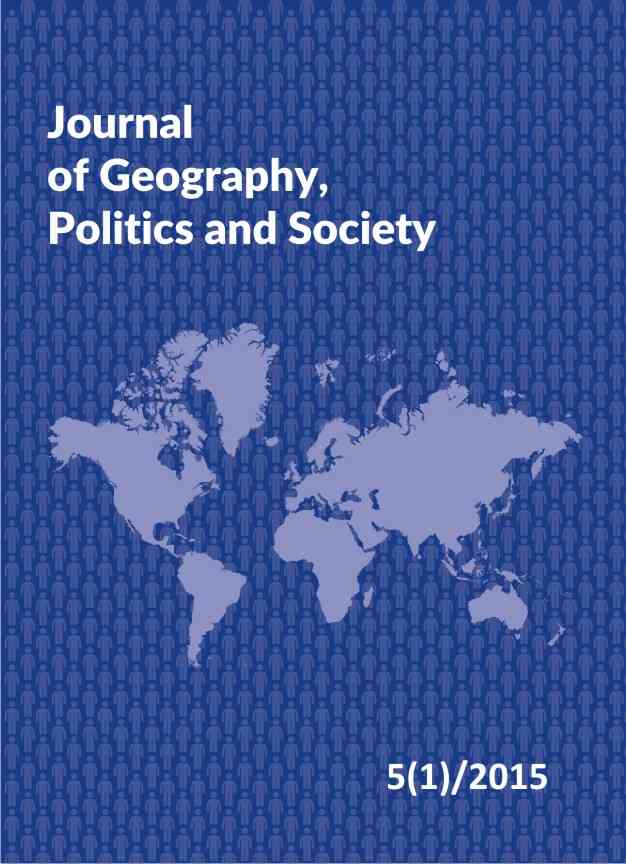Specifics of demographic transitions in Ukraine after the country gained independence
Keywords:
demographic transition model, second demographic transition model, demography, UkraineAbstract
Demographic transition processes in Ukraine following the country gaining independence correspond neither to the demographic transition model nor the second demographic transition model. Unsuccessful political, social and economic reforms at the time in Ukraine and pressure exerted by Russia are deemed to be the cause of the situation. This means that demographic transition in Ukraine (both in terms of mortality and births) is far more detrimental than the premises of both models.
Downloads
References
Adomanis M., 2015, Ukraine’s Economy Is A Disaster. Its Demography Is Even Worse, Forbes, http://www.forbes.com/sites/markadomanis/2015/05/30/ukraineseconomy-is-a-disaster-its-demography-is-evenworse/#2715e4857a0b5b0578cd1496 [20.11.2015].
Barnett T., Whiteside A., Khodakevich L., Kruglov Y., Stshenko V., 2000, The HIV/AIDS epidemic in Ukraine: its potential social and economic impact, Social Science & Medicine, 51, 1387–1403.
Bondar A., 2014, Russkij mir: umma czy cywilizacja? http://eastwestinfo.eu/kultura/wschodnie-narracje/skwarkiukrainskie/item/230-russkij-mir-uma-czy-cywilizacja [29.11.2015].
Caldwell J. C., 1976, Toward a Restatement of Demographic Transition Theory, Population and Development Review, 2(3/4), pp. 321–366.
Chuzhykov V., Fedirko O., Chuzhykov A., 2014, Methodological Background of Post-Soviet Regionalism: The Case of Ukraine, Baltic Journal of European Studies, 4, 20–33.
Ivanov D. I., 1999, Sexually Transmitted Diseases in Ukraine, Emerging Infectious Diseases, 5(3), 486–487.
Jilge A., 2014, Analyse: Die Ukraine aus Sicht der „Russkij Mir”, http://www.bpb.de/internationales/europa/russland/186517/analyse-die-ukraine-aus-sicht-der-russkijmir [29.11.2015].
Karklins R., 2005, The System Made Do It: Corruption in Post-Communist Sciences, M. E. Sharpe, Armonk – New York.
Kirk D., 1996, Demographic Transition Theory, Population Studies: a Journal of Demography, 50(3), 361–387.
Kotowska I. E., 1999, Drugie przejście demograficzne i jego uwarunkowania, [in:] I. E. Kotowska (ed.), Przemiany demograficzne w Polsce w latach 90. w świetle koncepcji drugiego przejścia demograficznego, Wydawnictwo SGH, Warszawa, 11–33.
Kuczabski A., Michalski T., 2014, Ukrainian post-communist transformation: causes, consequences and threats, Questiones Geographicae, 33(2), 171–180.
Kuzio T., 2015, Ukraine: democratization, corruption, and the new Russian imperialism, Praeger Security International. Santa Barbara-Denver.
Lekhan V., Rudiy V., Richardson E., 2010, Ukraine: Health system review, Health Systems in Transition, 12(8), 1–183.
Lesthaeghe R., 1995, The Second Demographic Transition – An Interpretation, [in:] K. O. Mason, A. M. Jensen (eds.), In Gender and Family Change in Industrial Countries, Clarendon Press, Oxford, 17–62.
Levchuk N., 2009, Alcohol and Mortality in Ukraine, series: MPIDR Working Paper WP 2009–017, Max-Planck-Institut für Demografische Forschung, Rostock.
Mavrov G. I., Bondarenko G. M., 2002, The evolution of sexually transmitted infections in the Ukraine, Sexually Transmitted Infections, 78, 219–221.
Moskwa D., 2013, W poszukiwaniu tożsamości narodowej – «Russkij» czy «Rossijskij Narod»? Наукові записки. Серія «Культурологія», 12, 63–78.
Richens J., Mircea B., 2009, Report of the Mission to Assess availability of and Access to STI services for most at risk and vulnerable populations in Ukraine, WHO Country Office in Ukraine, All-Ukrainian Network of PLWH, Kyiv.
Safarova G., Scherbov S., Pirozhkov S., 2008, Future trends of population ageing in Russia and Ukraine: a probabilistic view, Paper prepared for the European Population Conference 2008, Barcelona, Spain, July 9-12, 2008, http://epc2008.princeton.edu/papers/80730 [19.11.2015].
Sobotka T., 2008, The diverse faces of the Second Demographic Transition in Europe, Demographic Research, 19, 171–224.
Sokolnikov V., 2012a, Ukrainians and Russians in Ukraine and in Russia, [in:] F. Meslé, J. Vallin (eds.), Mortality and causes of death in 20th-century Ukraine, series: Demographic Research Monographs, 9, Springer, Dordrecht, 103–107.
Sokolnikov V., 2012b, Health Crises and Cohort Mortality, [in:] F. Meslé, J. Vallin (eds.), Mortality and causes of death in 20th-century Ukraine, series: Demographic Research Monographs, 9, Springer, Dordrecht, 109–116.
Szreter S., 1993, The Idea of Demographic Transition and the Study of Fertility Change: A Critical Intellectual History, Population and Development Review, 19(4), 659–701.
Tischner J., 2005, Etyka solidarności oraz Homo Sovieticus, Wydawnictwo Znak, Warszawa.
Tymkovych B., 2005, Reform of Healthcare Service Provision and Finance in Ukraine, [in:] G. Shakarishvili (ed.), Decentralization in Healthcare. Analyses and Experiences in Central and Eastern Europe in the 1990s, Local Government and Public Service Reform Initiative, Open Society Institute – Budapest, Budapest, 487–537.
Vallin J., Meslé F., Adamets S., Pyrozhkov S., 2012a, The Consequences of the Second World War and the Stalinist Repression, [in:] F. Meslé, J. Vallin (eds.), Mortality and causes of death in 20th-century Ukraine, series: Demographic Research Monographs, 9, Springer, Dordrecht, 39–74.
Vallin J., Meslé F., Adamets S., Pyrozhkov S., 2012b, The Crisis of the 1930s, [in:] F. Meslé, J. Vallin (eds.), Mortality and causes of death in 20th-century Ukraine, series: Demographic Research Monographs, 9, Springer, Dordrecht, 12–38.
Vojtěch V., 2010, Ethnic processes in post-communist Europe during the 1990s, Acta Universitatis Carolinae. Geographica, 2, 143–163.
Word Bank Open Data, http://data.worldbank.org/ [18.11.2015].
Zinoviev A., 1985. Homo Sovieticus, Atlantic Monthly Press, Boston.
Заствний Ф., 2006, Проблеми депресивності в Україні (соціально-економічної, екологічної, демографїчної), Видавничий центр ЛНУ імені Івана Франка, Львів.
Конончук С., 2006, Політика багатокультурності та консо- лидацйи українського суспільства: проблеми і пер- спективи, [in:] Ю. Тишченко (ed.), Регіональна політика України: формування соціогуманітарных притетів розвитку, Український Незалежний Центр Політичних Досліджень, Київ, 183–210.
Костя С. А. (ed.), 2012, Голодомор 1932–1933 років в Укрїні, ЛНУ імені Івана Франка, Львів. НАСЕЛЕННЯ УКРАЇНИ за 2014 рік. Демографічний щорічник, 2015, ДЕРЖАВНА СЛУЖБА СТАТИСТИКИ УКРАЇНИ, Київ.
Радченко О. В., 2008, Латинська Україна: нескінченість де- мократичного транзиту? Теорія та практика держав- ного управління, 3(22), 64–71.
Стефанишин О., 2006, Людськй потенціал економіки України, Видавничий центр ЛНУ імені Івана Франка, Львів.
Холод Н., 2009, Розподіл доходів та бідність у перехідних еконоіках, Видавничий центр ЛНУ імені Івана Франка, Львів.

 Academic Scientific Journals
Academic Scientific Journals




